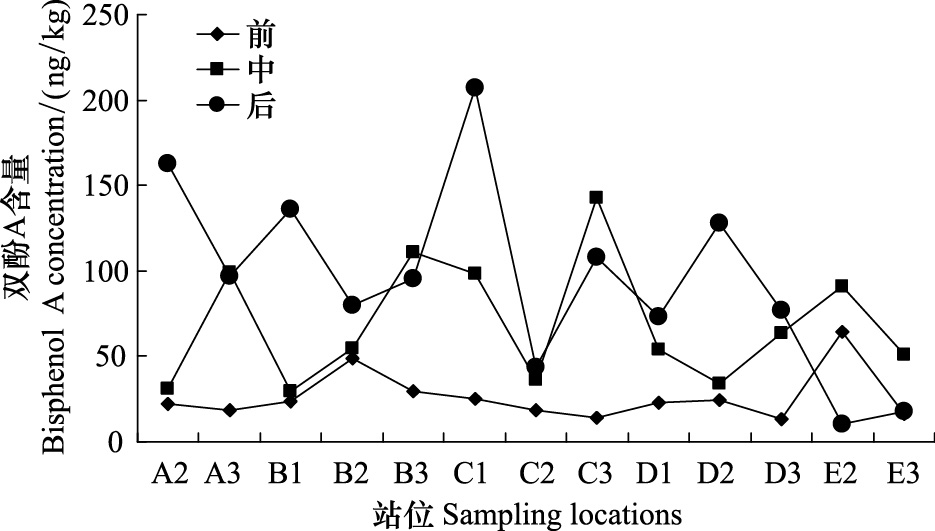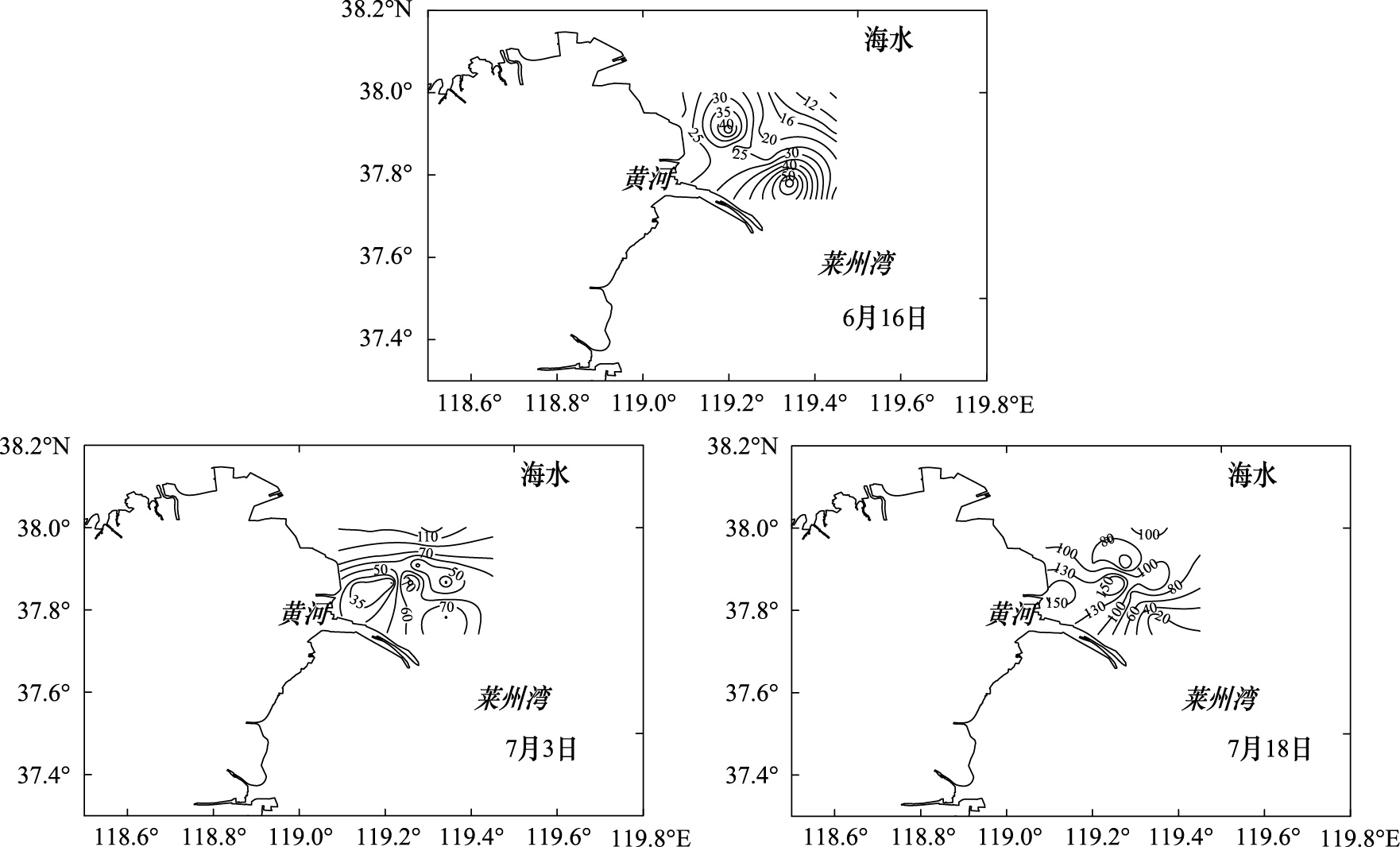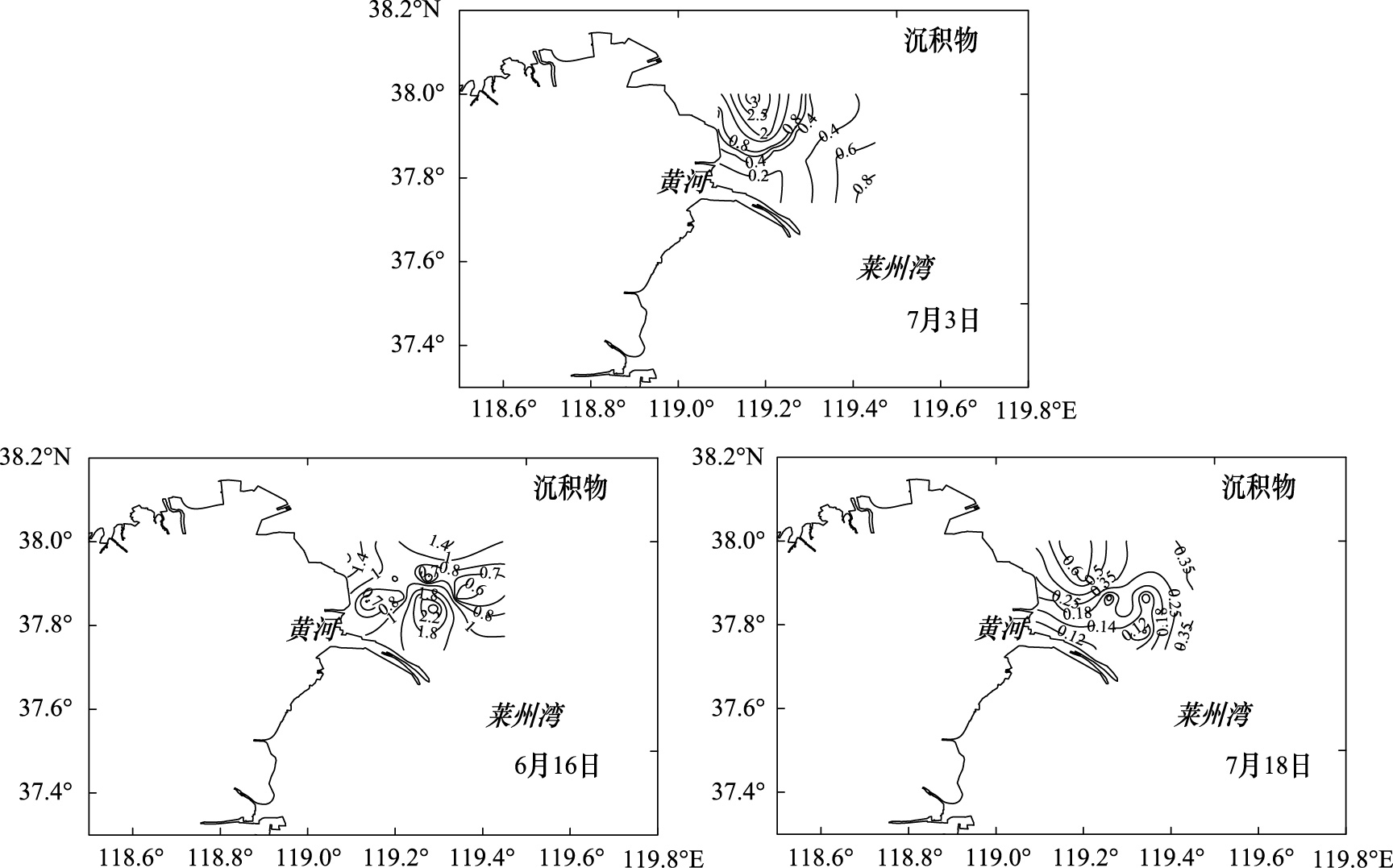文章信息
- 邹荣婕, 邓旭修, 王斌, 徐英江, 宫向红, 刘慧慧, 田秀慧, 张华威, 任传博, 李佳蔚, 吕振波
- ZOU Rongjie, DENG Xuxiu, WANG Bin, XU Yingjiang, GONG Xianghong, LIU Huihui, TIAN Xiuhui, ZHANG Huawei, REN Chuanbo, LI Jiawei, LÜ Zhenbo
- 黄河调水调沙对黄河口海域双酚A的影响
- Effect of water-sediment flushing events on bisphenol A contamination in the Yellow River estuary
- 生态学报, 2015, 35(2): 263-269
- Acta Ecologica Sinica, 2015, 35(2): 263-269
- http://dx.doi.org/10.5846/stxb201304010569
-
文章历史
- 收稿日期:2013-04-01
- 网络出版日期:2014-03-25
2. 烟台山水海产有限公司, 烟台 264006
2. Shanshui Marine Products CO., LTD, Yantai 264006, China
双酚A(BPA)学名2,2′-二(4-羟基苯基)丙烷,分子式为C15H16O2,是一种具有代表性的环境内分泌干扰物,被列为继臭氧层空洞和地球变暖之后的迫切需要治理的“第三代环境污染物”[1],已经被欧盟一些国家列入优先污染物的黑名单[2],国际组织已经将双酚A定为持久性有机污染物[3]。双酚A被广泛应用于杀真菌剂、染料及制造医疗器械、食品包装材料与饮料容器等塑料工业,是生产婴儿奶瓶、牙套、水瓶、食品饮料容器的原料。目前环境中的双酚A主要是由于生产和制造过程中低浓度直接排放和在制造或使用过程中的无序排放造成的[4]。城市污水和工业废水及其污泥、地表河流和垃圾渗滤液中常有检出。目前,大量的研究已经证明,由于双酚A具有雌激素活性,可以干扰人和动物体内正常的激素分泌,会导致代谢紊乱,所以它在环境中的分布特征也备受关注。
黄河是世界上最复杂、最难治理的一条河流,其主要症结在于泥沙,水少沙多,水沙不平衡。由于黄土高原严重的水土流失,造成大量泥沙在黄河下游强烈堆积,使黄河下游近800 km的河床还以年平均0.1 m的速度淤积抬高。为解决黄河下游泥沙淤积问题,黄河水利委员会自2002—2011年共进行了13次调水调沙。黄河调水调沙是利用人工扰动水库及河道泥沙的方式来改善黄河水沙时空的不平衡性和输沙用水的不足,以实现水沙关系的和谐[5]。据统计,黄河13次调水调沙累计进入下游总水量509.12亿m3,累计入海总沙量达7.62亿t。黄河河口区域是由黄河携带大量泥沙填充淤积而成的,河口是陆海交互作用的典型地带,具有水动力作用强烈、泥沙输移和物质交换频繁等特点,且受人类高强度活动的干扰和改造,是进行生态环境监测研究的理想区域。90年代以来,由于陆源排污量的迅猛增加,特别是黄河沿岸工农业的快速发展所带来的环境污染问题更是日趋严重,水体污染程度已达我国7大江河的第 2位[6],这些污染物最终通过黄河入海口排放入海,对海洋环境造成危害。2007—2010年发布的《山东省海洋环境质量公报》显示黄河口海洋环境污染严重,主要污染物为无机氮、活性磷酸盐、石油类和持续性有机污染物等。因此本研究选取黄河口邻近海域为研究对象,分析2011年黄河调水调沙前后该海域环境中双酚A的污染状况,探讨调水调沙对黄河口邻近海域污染程度的影响,进而对该海域双酚A污染状况进行科学评价,为科学制止和治理该海域污染提供基础数据。
1 材料与方法 1.1 实验主要仪器与试剂气相色谱质谱联用仪(6890N-5973i,Agilent,USA);超纯水仪(Milli Q Gradient,Millipore,France);超声波清洗器(KQ-600E,昆山市超声仪器有限公司);高速离心机(TGL-10 C,安亭科学仪器厂,上海);氮吹仪(N-EVAPTM112,Organomation Associates,USA);旋转蒸发仪(R-215,Buchi,Switzerland)等。
甲醇,丙酮,环己烷,正己烷均为色谱级(Merck);盐酸为分析纯(科密欧试剂);七氟丁酸酐(纯度>99.0%,Sigma),铜粉为分析纯(阿拉丁试剂);所用水为超纯水;双酚A标准品(CAS号:80-05-7,纯度>98.5%,Dr.);固相萃取小柱:HLB,60 mg/3 mL(Waters);石墨化碳,500 mg/6 mL(Agilent)。
1.2 实验方法 1.2.1 样品采集本次研究在黄河河口区域内以均匀布设原则设置了13个站位,如图 1所示。本次调水调沙从6月19日开始,7月12日结束,持续23d。调水调沙水头6月24日进入东营市河道,流量超过2000 m3/s,利津站最大流量3200 m3/s,水位12.98 m。7月12日上午8时,黄河最下游的利津水文站实测流量跌落至465 m3/s,标志着黄河调水调沙流量已全部入海,2011年黄河调水调沙顺利结束。本试验于2011年 6月16日(调沙前)、7月3日(调沙中期)、7月18日(调沙后),3次采集表层水体和沉积物样品。

|
| 图 1 取样站位示意图 Fig. 1 Sampling locations in the Yellow River Estuary |
表层水水样采集使用采样桶,采集后装入棕色玻璃瓶,样品采集后倒立放在暗处低温(4 ℃)保存。沉积物样品采用抓斗式采泥器(0.1 m2)采集,每个站位采集约200 g表层(3 cm厚度以内)沉积物,直接置于-20 ℃的冰柜中保存。所有的样品运回实验室后在2个月内测定。
1.2.2 样品前处理海水样品:用0.45 μm混合纤维素滤膜抽滤海水样品500 mL(准确到1.0 mL),用6 mol/L盐酸溶液调pH值至2—3,加入甲醇40 mL,混匀,用HLB小柱进行固相萃取。甲醇溶液(V甲醇 ∶ V水=1 ∶ 1)10 mL淋洗柱子,10 mL甲醇洗脱,吹干,用乙酸乙酯复溶转入进样瓶中浓缩。衍生:于上述进样瓶中加入七氟丁酸酐30 μL、丙酮70 μL,于30 ℃恒温箱中衍生30 min,氮气吹干,用正己烷定容至0.5 mL,供GC-MS分析。
沉积物样品:准确称取10 g自然风干后的样品,加20 mL甲醇超声提取20 min,残渣重复提取一次,合并两次提取液。用事先处理好的铜粉,震荡除硫,40 ℃旋转蒸发至干,用2 mL环己烷溶解残留物。过预先用10 mL环己烷活化的石墨化碳固相萃取小柱,10 mL环己烷-丙酮混合液(V环己烷 ∶ V丙酮=1 ∶ 1)洗脱,收集洗脱液,氮气吹干。同水样相同的衍生方法衍生 30 min,氮气吹干,用正己烷定容至0.5 mL,供GC-MS分析。
1.2.3 测定条件色谱条件: 色谱柱为HP-5 ms,30 m×0.25 mm(i. d.)×0.25 μm,柱温120 ℃保持2 min,以 15 ℃/min 升至250 ℃,以5 ℃/min升至300 ℃,保持5 min;载气高纯氦气,流量1.0 mL/min;进样口温度250 ℃;进样方式不分流进样,不分流时间1 min,进样量1 μL。
质谱条件:离子源为EI;离子源温度230 ℃;四级杆温度150 ℃;接口温度280 ℃;溶剂延迟7 min;扫描方式选择离子扫描(SIM);定性离子620、331、315;定量离子605。
1.3 质量控制和质量保证过程空白样品中没有检出目标化合物双酚A。空白海水中加标回收率为82.1%—90.2%,相对标准偏差为4.5%,以S/N=10计,方法定量限为3 ng/L。空白沉积物中加标回收率为72.8%—85.6%,相对标准偏差为6.9%,以S/N=10计,方法定量限为0.3 μg/kg。样品分析过程中,每个样品平行测定2次,每隔 10个样品,进行QA/QC控制样品分析,包括标准溶液、试剂空白、过程空白及加标回收率。
2 结果与讨论 2.1 黄河口海域表层海水中双酚A的分布特征黄河口13个站位海水中均有双酚A检出,浓度为13.6—64.0 ng/L(以调水调沙前测定的海水中双酚A含量评估黄河口附近双酚A的污染程度),平均浓度为26.2 ng/L,最高浓度出现在E2站位,最低浓度出现在D3站位。除B2、E2站位双酚A浓度较高之外,其余站位的双酚A浓度大约都在20 ng/L上下(图 2)。分布规律为离河口越近的站位双酚A浓度越高,然后向远海逐渐降低。远岸站位海域比较宽阔,水交换条件比较好,双酚A浓度较低(图 3)。

|
| 图 2 2011年调水调沙前后黄河口区域海水中双酚A含量的变化 Fig. 2 Variations of bisphenol A concentration in the surface waters at the Yellow River estuary station during the period of water-sediment regulation in 2011 |

|
| 图 3 2011年调水调沙前后海水中双酚A含量 (ng/L) 平面分布 Fig. 3 Horizontal distribution of bisphenol A concentration in the surface waters a during the period of water-sediment regulation in 2011 |
国内外对水体中双酚A的研究也多有报道。天津海河水体中双酚A的浓度为19.1— 106 ng/L[7] ;珠江口表层水中双酚A浓度为1.17—3.92 μg/L[8];冬季胶州湾中双酚A的浓度为3.8—161.5 ng/L[9];松花江水双酚A含量为13.0—206.5 ng/L[10];韩国西瓦湖水体双酚A的浓度为6.7—37.8 ng/L[11];德国Rhine河中的双酚A浓度为10—119 ng/L[4],黄河口海域海水中双酚A浓度超过韩国西瓦湖,低于天津海河、珠江口、胶州湾、松花江和德国Rhine河,污染状况属于中等水平。
2.2 黄河口海域沉积物中双酚A的分布沉积物是众多污染物在环境中迁移转化的载体、归宿和蓄积库。一些在水中溶解度较低的有机物质易被颗粒物吸附,沉降于河底并难以降解,这在一定程度上对水体起到了吸附净化作用,但同时它将作为有机污染物长期的潜在释放源,对水生生物和人体健康产生危害[12]。由于双酚A水溶性小,污染物容易被吸附到悬浮体上,然后转移到沉积物中,因此沉积物中的含量要远远高于水体。以调水调沙前沉积物中双酚A的含量评估黄河口附近双酚A的污染程度,黄河口沉积物中双酚A浓度为0.559—2.73 μg/kg 干重,平均浓度为1.19 μg/kg,是海水中平均含量的48倍,靠近黄河入海口区域的站位,双酚A浓度比较高(图 4和图 5)。本研究的结果高于渤海表层沉积物(ND—1.44 μg/kg)[13] 和韩国Yeongil湾(<1 μg/kg)中双酚A浓度[14];低于胶州湾(0.7—5.4 μg/kg)[9]、长江入海口及其毗邻的东海海域(0.72—13.2 μg/kg)[15]及韩国西瓦湖沉积物中双酚A的浓度(1.3—11.2 μg/kg)[11];远远低于韩国马山湾(2.7—50.3 μg/kg)[16]和韩国南部Masan湾中双酚A浓度(2.70—50.3 μg/kg)[16],处于中等污染状态。

|
| 图 4 2011年调水调沙前后黄河口区域沉积物中双酚A含量的变化 Fig. 4 Variations of bisphenol A concentration in the sediments at the Yellow River estuary station during the period of water-sediment regulation in 2011 |

|
| 图 5 2011年调水调沙前后沉积物中双酚A含量 (μg/kg ) 平面分布 Fig. 5 Horizontal distribution of bisphenol A concentration in sediment during the period of water-sediment regulation in 2011 |
通过SPSS 13.0统计软件LSD法对调水调沙前、中期、后3次水样和沉积物的分析结果进行差异显著性分析后发现,对于离入海口较近的A2,B1,C1,D1站位来说,调水调沙后海水中双酚A的浓度明显增高(浓度范围为73.2—207.0 ng/L),与调水调沙前差异极显著(P<0.01),平均浓度增高了6倍;对于远岸的A3,B3,C3,D3,E3站位来说,调水调沙中(浓度范围为50.7—143.0 ng/L)和调水调沙后(浓度范围为18.0—108.0 ng/L)海水中双酚A的浓度都与调水调沙前差异极显著(P<0.01),调水调沙中期比调水调沙前平均浓度增高了5倍;调水调沙后比调水调沙前平均浓度增高了4倍。
黄河河口区域中双酚A的污染来源主要是陆源输入,调水调沙期间,巨大的径流量携带了黄河上游大量的污染物,直接排放入海,应该是造成调水调沙前后海水中双酚A含量差异显著的主要原因。
黄河调水调沙分为两个阶段,第一阶段为小浪底水库放水造峰;第二阶段在小浪底水库基本放空时三门峡等水库放水,在落水期进行异重流排沙与之搭接。调水调沙对下游河道冲刷作用主要是第一阶段放水造峰形成[17]。沉积物中测得的双酚A含量,调水调沙前与调水调沙中(浓度范围为0.230—0.507 μg/kg)、调水调沙后(浓度范围为0.094—0.274 μg/kg)差异极显著(P<0.01),调水调沙后含量显著降低;而离河口较远的站位,调水调沙前、中、后差异不显著。沉积物中双酚A浓度的差异性变化,可能有以下几个方面原因:(1)河口附近的站位是黄河调水调沙的主要承泄区,调水调沙过程是一个动态的过程,调水调沙中期大量黄河上游浅层泥沙冲到河口区域,浅层泥沙双酚A的污染程度比底层泥沙高(孙卫玲等[18]研究表明:黄河泥沙悬浮颗粒物有机质含量明显高于底泥,粒径也比底泥细,所以双酚A的吸附量明显大),泥沙各个层面双酚A含量的不均匀应该是导致调水调沙中期比调水调沙后高很多的一个主要原因。(2)双酚A的污染来源主要是陆源输入,双酚A水溶性小,在沉积物中的沉降富集是一个长期的过程,其中还伴随有泥沙的不断运移和悬浮物的沉降。调水调沙过程中,从上游携带下来的大量双酚A悬浮于水中,经过长时间的沉降富集,表层泥沙中的双酚A含量会比调水调沙后马上测得的双酚A浓度高,这应该是调水调沙后测得的双酚A含量显著比调水调沙前低的一个主要原因。至于产生上述结果的具体原因,还需要进一步进行调查研究。
2.4 黄河口海域双酚A潜在生态风险评估双酚A属于内分泌干扰物,且具有致癌性,当水体中双酚A浓度达到1 μg/L时,能引起腹足类Nucella lapillus雄性个体出现雌性化特征[19]。Duft等还报道了双酚A对泥螺胚胎生成的4周半效应浓度(EC50)为5.67 μg/kg,10%效应浓度(EC10)仅为0.19 μg/kg[20]。本研究数据显示,黄河口沉积物中双酚A的平均浓度为1.19 μg/kg,因此河口附近的一些生物可能已经受到了双酚A的危害,这方面的研究还有待于进一步开展。
3 结论(1)黄河河口区域13个站位表层海水和沉积物中均有双酚A检出,以调水调沙前海水和沉积物中双酚A的含量评估黄河口附近双酚A的污染程度。海水中双酚A浓度为13.6—64.0 ng/L,平均浓度为26.2 ng/L,分布规律为离河口越近的站位双酚A浓度较高,然后向远海逐渐降低;沉积物中双酚A的浓度为0.559—2.73 μg/kg 干重,平均浓度为1.19 μg/kg,是海水中平均含量的48倍,靠近黄河入海口区域的站位,双酚A浓度比较高。
(2)黄河河口区域海水中双酚A浓度受调水调沙影响而呈现较大变化,调水调沙后的双酚A浓度明显提高,调水调沙前与调水调沙后水中的双酚A浓度呈显著性差异(P<0.01)。离入海口近的站位,沉积物中双酚A浓度受调水调沙影响较大,调水调沙前与调水调沙中、后呈显著性差异(P<0.01),调水调沙后含量显著降低。
(3)所监测13个站位中,所有站位的双酚A浓度均超过10%效应浓度(EC10),河口附近的一些生物可能已经受到了双酚A的危害,存在生态安全问题。
| [1] | 蒋俊, 李秀艳. 水环境内分泌干扰物双酚A的降解研究进展. 上海化工, 2009, 34(4): 25-30. |
| [2] | Craig D R, Brown E, Craft J A, Davies I M, Moffat C F, Pirie D, Robertson F, Stagg R M, Struthers S. Effects of sewage effluent and ethynyl oestradiol upon molecular markers of oestrogenic exposure, maturation and reproductive success in the sand goby ( Pomatoschistus minutus, Pallas). Aquatic Toxicology, 2003, 62(2): 119-134. |
| [3] | 黄少婵, 杭义萍. 液相色谱-质谱法同时测定塑料制品中的双酚A和四溴双酚A. 色谱, 2010, 28(9): 863-866. |
| [4] | Staples C A, Dorn P B, Klecka G M, Oblock S T, Harris L R. A review of the environmental fate, effects, and exposures of bisphenol A. Chemosphere, 1998, 36(10): 2149-2173. |
| [5] | 李国英. 黄河第三次调水调沙试验. 人民黄河, 2004, 26(10): 1-8. |
| [6] | 张大伟, 徐辉, 王刚. 黄河流域水污染问题研究. 人民黄河, 2005, 25(10): 12-13, 16. |
| [7] | Jin X L, Jiang G B, Huang G L, Liu J F, Zhou Q F. Determination of 4-tert-octylphenol, 4-nonylphenol and bisphenol A in surface waters from the Haihe River in Tianjin by gas chromatography-mass spectrometry with selected ion monitoring. Chemosphere, 2004, 56(11): 1113-1116. |
| [8] | 董军, 李向丽, 梁锐杰. 珠江口地区水体中双酚A污染及其与环境因子的关系. 生态与农村环境学报, 2009, 25(2): 94-97. |
| [9] | 李正炎, 傅明珠, 王馨平, 高会旺. 冬季胶州湾及其周边河流中酚类环境激素的分布特征. 中国海洋大学学报: 自然科学版, 2006, 36(3): 451-455. |
| [10] | 张照韩, 冯玉杰, 高鹏, 孙清芳, 任南琪. 松花江水内分泌干扰物及雌激素活性调查. 哈尔滨工业大学学报, 2011, 43(12): 58-62. |
| [11] | 李正炎, Li D H. 西瓦湖及其邻近河流中双酚A的浓度分布. 海洋湖沼通报, 2004, (2): 30-35. |
| [12] | 阎波, 杨卫芳, 李烨, 李劲. 洹河底泥中有机污染物调查与分析. 环境科学与技术, 2004, 27(1): 44-46. |
| [13] | 邵亮, 边海燕, 李正炎. 夏季渤海表层沉积物中壬基酚和双酚A的分布特征与潜在生态风险. 海洋环境科学, 2011, 30(2): 158-161. |
| [14] | Kon C H, Khim J S, Villeneuve D L, Kannan K, Giesy J P. Characterization of trace organic contaminants in marine sediment from Yeongil Bay, Korea: 1. Instrumental analyses. Environmental Pollution, 2006, 142(1): 39-47. |
| [15] | Bian H Y, Li Z Y, Liu P, Pan J F. Spatial distribution and deposition history of nonylphenol and bisphenol A in sediments from the Changjiang River (Yangtze River) Estuary and its adjacent East China Sea. Acta Oceanologica Sinica, 2010, 29(5): 44-51. |
| [16] | Khim J S, Kannan K, Villeneuve D L, Koh C H, Giesy J P. Characterization and distribution of trace organic contaminants in sediment from Masan Bay, Korea: 1. Instrumental analysis. Environmental Science and Technology, 1999, 33(23): 4199-4205. |
| [17] | 齐璞, 曲少军, 孙赞盈. 优化小浪底水库调水调沙运用方式的建议. 人民黄河, 2012, 34(1): 5-8. |
| [18] | 孙卫玲, 倪晋仁, 郝鹏鹏, 孙莉英. 泥沙对双酚A的吸附及其影响因素研究. 环境科学学报, 2004, 24(6): 975-981. |
| [19] | Oehlmann J, Schulte-Oehlmann U, Tillmann M, Tillmann B. Effects of endocrine disruptors on Prosobranch Snails (Mollusca: Gastropoda) in the Laboratory. Part I: Bisphenol A and Octylphenol as Xeno-Estrogens. Ecotoxicology, 2000, 9(6): 383-397. |
| [20] | Duft M, Schulte-Oehlmann U, Weltje L, Tillmann J, Oehlmann J. Stimulated embryo production as a parameter of estrogenic exposure via sediments in the freshwater mudsnail Potamopyrgus antipodarum. Aquatic Toxicology, 2003, 64(4): 437-449. |
 2015, Vol. 35
2015, Vol. 35




